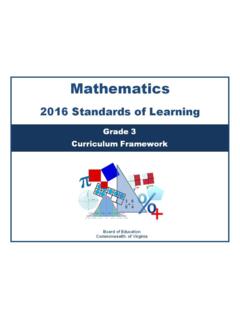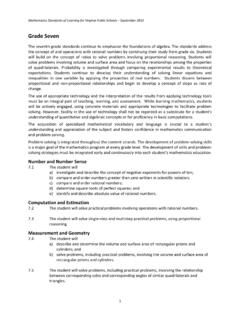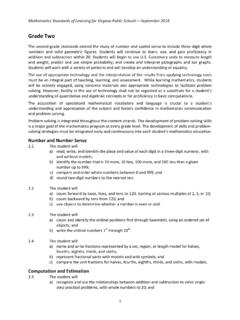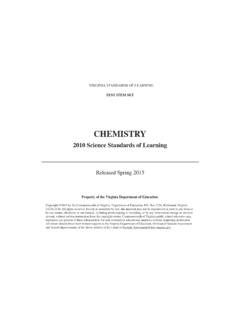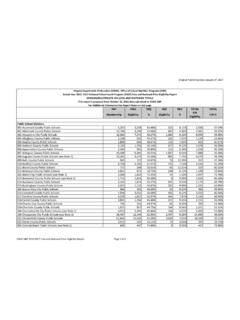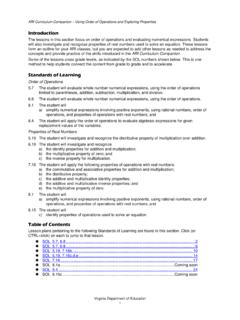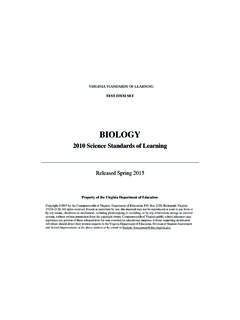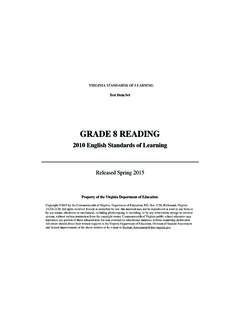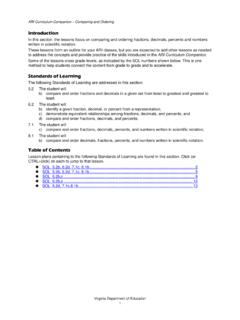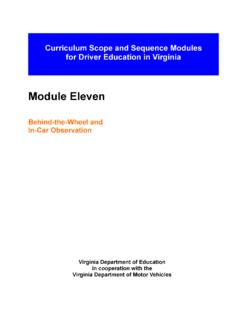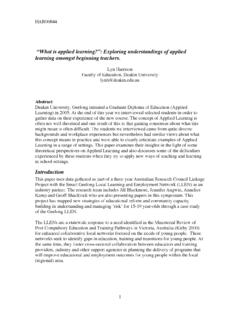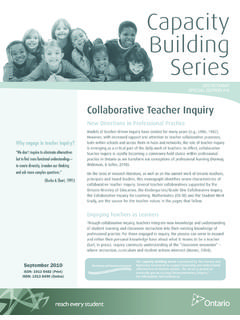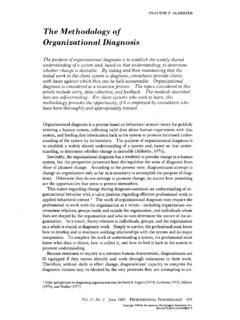Transcription of Copyright © 2016
1 Copyright 2016. by the Virginia Department of Education Box 2120. Richmond, Virginia 23218-2120. All rights reserved. Reproduction of these materials for instructional purposes in public school classrooms in Virginia is permitted. Superintendent of Public Instruction Steven R. Staples Chief Academic Officer/Assistant Superintendent for Instruction Steven M. Constantino Office of Mathematics and Governor's Schools Debra Delozier, Mathematics Specialist Tina Mazzacane, Mathematics and Science Specialist Christa Southall, Mathematics Specialist Acknowledgements The Virginia Department of Education wishes to express sincere thanks to Michael Bolling, who assisted in the development of the 2016 Mathematics Standards of learning and 2016 Mathematics Standards of learning Curriculum Framework.
2 NOTICE. The Virginia Department of Education does not unlawfully discriminate on the basis of race, color, sex, national origin, age, or disability in employment or in its educational programs or services. Virginia 2016 Mathematics Standards of learning Curriculum Framework Introduction The 2016 Mathematics Standards of learning Curriculum Framework, a companion document to the 2016 Mathematics Standards of learning , amplifies the Mathematics Standards of learning and further defines the content knowledge, skills, and understandings that are measured by the Standards of learning assessments.
3 The standards and Curriculum Framework are not intended to encompass the entire curriculum for a given grade level or course. School divisions are encouraged to incorporate the standards and Curriculum Framework into a broader, locally designed curriculum. The Curriculum Framework delineates in greater specificity the minimum content that all teachers should teach and all students should learn. Teachers are encouraged to go beyond the standards as well as to select instructional strategies and assessment methods appropriate for all students. The Curriculum Framework also serves as a guide for Standards of learning assessment development.
4 Students are expected to continue to connect and apply knowledge and skills from Standards of learning presented in previous grades as they deepen their mathematical understanding. Assessment items may not and should not be a verbatim reflection of the information presented in the Curriculum Framework. Each topic in the 2016 Mathematics Standards of learning Curriculum Framework is developed around the Standards of learning . The format of the Curriculum Framework facilitates teacher planning by identifying the key concepts, knowledge, and skills that should be the focus of instruction for each standard.
5 The Curriculum Framework is divided into two columns: Understanding the Standard and Essential Knowledge and Skills. The purpose of each column is explained below. Understanding the Standard This section includes mathematical content and key concepts that assist teachers in planning standards-focused instruction. The statements may provide definitions, explanations, examples, and information regarding connections within and between grade level(s)/course(s). Essential Knowledge and Skills This section provides a detailed expansion of the mathematics knowledge and skills that each student should know and be able to demonstrate.
6 This is not meant to be an exhaustive list of student expectations. VDOE Mathematics Standards of learning Curriculum Framework 2016: Kindergarten Mathematical Process Goals for Students The content of the mathematics standards is intended to support the following five process goals for students: becoming mathematical problem solvers, communicating mathematically, reasoning mathematically, making mathematical connections, and using mathematical representations to model and interpret practical situations. Practical situations include real-world problems and problems that model real-world situations.
7 Mathematical Problem Solving Students will apply mathematical concepts and skills and the relationships among them to solve problem situations of varying complexities. Students also will recognize and create problems from real-world data and situations within and outside mathematics and then apply appropriate strategies to determine acceptable solutions. To accomplish this goal, students will need to develop a repertoire of skills and strategies for solving a variety of problems. A major goal of the mathematics program is to help students apply mathematics concepts and skills to become mathematical problem solvers.
8 Mathematical Communication Students will communicate thinking and reasoning using the language of mathematics, including specialized vocabulary and symbolic notation, to express mathematical ideas with precision. Representing, discussing, justifying, conjecturing, reading, writing, presenting, and listening to mathematics will help students clarify their thinking and deepen their understanding of the mathematics being studied. Mathematical communication becomes visible where learning involves participation in mathematical discussions. Mathematical Reasoning Students will recognize reasoning and proof as fundamental aspects of mathematics.
9 Students will learn and apply inductive and deductive reasoning skills to make, test, and evaluate mathematical statements and to justify steps in mathematical procedures. Students will use logical reasoning to analyze an argument and to determine whether conclusions are valid. In addition, students will use number sense to apply proportional and spatial reasoning and to reason from a variety of representations. Mathematical Connections Students will build upon prior knowledge to relate concepts and procedures from different topics within mathematics and see mathematics as an integrated field of study.
10 Through the practical application of content and process skills, students will make connections among different areas of mathematics and between mathematics and other disciplines, and to real-world contexts. Science and mathematics teachers and curriculum writers are encouraged to develop mathematics and science curricula that support, apply, and reinforce each other. Mathematical Representations Students will represent and describe mathematical ideas, generalizations, and relationships using a variety of methods. Students will understand that representations of mathematical ideas are an essential part of learning , doing, and communicating mathematics.
